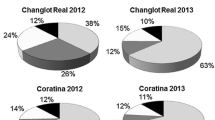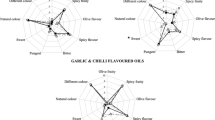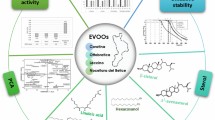Abstract
Within extra-virgin olive oil (EVOO) global market, there is a niche market of olive oils flavoured with aromatic and medicinal plants. The use of aromatic and medicinal plants to flavour extra-virgin olive oils enriches the oil both from a sensorial and nutritional point of view, affecting its chemical composition. It is, therefore, necessary to develop analytical techniques useful to investigate in deeply the quali-quantitative profile of molecules contained in both the volatile and non-volatile fractions of extra-virgin olive oil. In the current study, several flavoured EVOOs (with truffle, basil, cardamom, bergamot, lemon, mandarin, sage, porcini mushroom, garlic, and rose) were purchased from local stores and analysed by both HPLC and GC methods to verify the correspondence with the profile of the added aroma. Furthermore, considering the preciousness and cost of some specific flavouring ingredients, in some cases, multidimensional gas chromatographic approach coupled to IRMS or performed by a chiral separation (Es-MDGC) was led to investigate their authenticity. From the results obtained, these complementary approaches allowed confirming the genuineness for most of the flavoured EVOOs. For few flavourings, some differences were detected with respect to literature references, thus requiring additional analytical devices to further authenticate their genuineness.



Similar content being viewed by others
Data Availability
All data generated or analysed during this study are included in this published article and its supplementary information files.
References
Akram M, Riaz M, Munir N, Akhter N, Zafar S, Jabeen F, Shariati MA, Akhtar N, Riaz Z, Altaf SH, Daniyal M, Zahid R, Khan FS (2020) Chemical constituents, experimental and clinical pharmacology of Rosa damascena : a literature review. J Pharm Pharmacol 72:161–174. https://doi.org/10.1111/jphp.13185
Alves FCGBS, Coqueiro A, Março PH, Valderrama P (2019) Evaluation of olive oils from the Mediterranean region by UV–Vis spectroscopy and independent component analysis. Food Chem 273:124–129
Angerosa F, Servili M, Selvaggini R, Taticchi A, Esposto S, Montedoro G (2004) Volatile compounds in virgin olive oil: occurrence and their relationship with the quality. J Chromatogr A 1054:17–31. https://doi.org/10.1016/j.chroma.2004.07.093
Anwar F, Abbas A, Alkharfy KM, Gilani A-H (2016) Cardamom (Elettaria cardamomum Maton) oils. In Elsevier ed Essential oils in food preservation, flavor and safety, pp 295–301. https://doi.org/10.1016/B978-0-12-416641-7.00033-X
Arigò A, Dugo P, Rigano F, Mondello L (2021) Linear retention index approach applied to liquid chromatography coupled to triple quadrupole mass spectrometry to determine oxygen heterocyclic compounds at trace level in finished cosmetics. J Chromatogr A 1649:462183. https://doi.org/10.1016/j.chroma.2021.462183
Asensio CM, Nepote V, Grosso NR (2013) Consumers’ acceptance and quality stability of olive oil flavoured with essential oils of different oregano species. Int J Food Sci Technol 48:2417–2428. https://doi.org/10.1111/ijfs.12233
Ayadi MA, Grati-Kamoun N, Attia H (2009) Physico-chemical change and heat stability of extra virgin olive oils flavoured by selected Tunisian aromatic plants. Food Chem Toxicol 47:2613–2619. https://doi.org/10.1016/j.fct.2009.07.024
Baiano A, Terracone C, Gambacorta G, Notte EL (2009) Changes in quality indices, phenolic content and antioxidant activity of flavored olive oils during storage. J Americ Oil Chem Soc 86:1083–1092. https://doi.org/10.1007/s11746-009-1446-8
Belitz HD, Grosch W, Schieberle P (2009) Lipids. Food chemistry, 4th revised and extended. Springer-Verlag, Berlin Heidelberg, Berlin, pp 158–247
Benkhoud H, M’Rabet Y, Gara ali M, Mezni M, Hosni K (2022) Essential oils as flavoring and preservative agents: impact on volatile profile, sensory attributes, and the oxidative stability of flavored extra virgin olive oil. J Food Process Preserv 46:e15379. https://doi.org/10.1111/jfpp.15379
Bittencourt Fagundes M, Ballus CA, Perceval Soares V, de Freitas Ferreira D, Sena Vaz Leães Y, Sasso Robalo S, Guidetti Vendruscolo R, Bastianello Campagnol PC, Smanioto Barin J, Cichoski AJ, Bevilacqua Marcuzzo S, Assumpção Bertuol D, Wagner R (2020) Characterization of olive oil flavored with Brazilian pink pepper (Schinus terebinthifolius Raddi) in different maceration processes. Food Res Int 137:109593. https://doi.org/10.1016/j.foodres.2020.109593
Bobiano M, Rodrigues N, Madureira M, Dias LG, Veloso ACA, Pereira JA, Pere AM (2019) Unmasking sensory defects of olive oils flavored with basil and oregano using an electronic tongue-chemometric tool. J Am Oil Chem Soc 96:751–760. https://doi.org/10.1002/aocs.12249
Bonaccorsi I, Sciarrone D, Cotroneo A, Mondello L, Dugo P, Dugo G (2011) Enantiomeric distribution of key volatile components in Citrus essential oils. Rev Bras Farmacogn 21:841–849. https://doi.org/10.1590/S0102-695X2011005000123
Cecchi T, Alfei B (2013) Volatile profiles of Italian monovarietal extra virgin olive oils via HS-SPME–GC–MS: newly identified compounds, flavors molecular markers, and terpenic profile. Food Chem 141:2025–2035. https://doi.org/10.1016/j.foodchem.2013.05.090
Cecchi L, Migliorini M, Mulinacci N (2021) Virgin olive oil volatile compounds: composition, sensory characteristics, analytical approaches, quality control, and authentication. J Agric Food Chem. 69(7):2013–2040. https://doi.org/10.1021/acs.jafc.0c07744
Clodoveo ML, Dipalmo T, Crupi P, Durante V, Pesce V, Maiellaro I, Lovece A, Mercurio A, Laghezza A, Corbo F, Franchini C (2016) Comparison between different flavored olive oil production techniques: healthy value and process efficiency. Plant Foods Hum Nutr 71:81–87. https://doi.org/10.1007/s11130-016-0528-7
Cucinotta L, De Grazia G, Salerno TMG, Donnarumma D, Donato P, Sciarrone D, Mondello L (2021) Overcoming the lack of reliability associated to monodimensional gas chromatography coupled to isotopic ratio mass spectrometry data by heart-cut two-dimensional gas chromatography. J Chromatogr A 1655(5):462473. https://doi.org/10.1016/j.chroma.2021.462473
Cucinotta L, De Grazia G, Micalizzi G, Bontempo L, Camin F, Mondello L, Sciarrone D (2022) Simultaneous evaluation of the enantiomeric and carbon isotopic ratios of Cannabis sativa L. essential oils by multidimensional gas chromatography. Anal Bioanal Chem 414:5643–5656. https://doi.org/10.1007/s00216-022-04035-1
Díaz-Montaña EJ, Barbero-López M, Aparicio-Ruiz R, Morales MT (2022) Does a flavoured extra virgin olive oil have higher antioxidant properties? Antioxidants 11:550. https://doi.org/10.3390/antiox11030550
Dugo P, Ragonese C, Russo M, Sciarrone D, Santi L, Cotroneo A, Mondello L (2010) Sicilian lemon oil: composition of volatile and oxygen heterocyclic fractions and enantiomeric distribution of volatile components. J Sep Sci 33:3374–3385. https://doi.org/10.1002/jssc.201000578
Dugo L, Russo M, Cacciola F, Mandolfino F, Salafia F, Vilmercati A, Fanali C, Casale M, De Gara L, Dugo P, Mondello L, Rigano F (2020) Determination of the phenol and tocopherol content in Italian high-quality extra-virgin olive oils by using LC-MS and multivariate data analysis. Food Anal Meth 13:1027–1041
Dugo G, Cotroneo A, Bonaccorsi I, Trozzi A (2010) Composition of the volatile fraction of citrus peel oils. In: Dugo G, Mondello L (eds) Citrus oils composition, advanced analytical techniques, contaminants, and biological activity. CRC Press Taylor & Francis Group, Boca Raton, FL, pp 1–149
Dziri S, Casabianca H, Hanchi B, Hosni K (2014) Composition of garlic essential oil (Allium sativum L.) as influenced by drying method. J Essent Oil Res 26:91–96. https://doi.org/10.1080/10412905.2013.868329
EFSA Panel on Dietetic Products, Nutrition and Allergies (NDA). Scientific Opinion on the substantiation of health claims related to polyphenols in olive and protection of LDL particles from oxidative damage (ID 1333, 1638, 1639, 1696, 2865), maintenance of normal blood HDL-cholesterol concentrations (ID 1639), maintenance of normal blood pressure (ID 3781), “anti-inflammatory properties” (ID 1882), “contributes to the upper respiratory tract health” (ID 3468), “can help to maintain a normal function of gastrointestinal tract” (3779), and “contributes to body defences against external agents” (ID 3467) pursuant to Article 13(1) of Regulation (EC) No 1924/2006. EFSA J. 2011, 9, 2033. Available online: www.efsa.europa.eu/efsajournal (Accessed 25 May 2022)
European Commission (2012) Commission Regulation (EU) No 432/2012 (16 May 2012) Establishing a list of permitted health claims made on foods, other than those referring to the reduction of disease risk and to children’s development and health. Off J Eur Union L136:1–40
Frizzo CD, Lorenzo D, Dellacassa E (2004) Composition and seasonal variation of the essential oils from two mandarin cultivars of Southern Brazil. J Agric Food Chem 52:3036–3041. https://doi.org/10.1021/jf030685x
Gioacchini AM, Menotta M, Guescini M, Saltarelli R, Ceccaroli P, Amicucci A, Barbieri E, Giomaro G, Stocchi V (2008) Geographical traceability of Italian white truffle (Tuber magnatum Pico) by the analysis of volatile organic compounds: geographical traceability of Italian white truffle. Rapid Commun Mass Spectrom 22:3147–3153. https://doi.org/10.1002/rcm.3714
Kovats E (1987) Composition of essential oils Part 7: Bulgarian oil of rose (Rosa Damascena Mill.). J Chromatogr 406:185–222
Krupčík J, Gorovenko R, Špánik I, Sandra P, Armstrong DW (2015) Enantioselective comprehensive two-dimensional gas chromatography. A route to elucidate the authenticity and origin of Rosa damascena Miller essential oils: Gas Chromatography. J Sep Science 38:3397–3403. https://doi.org/10.1002/jssc.201500744
Lamas S, Rodrigues N, Peres AM, Pereira JA (2022) Flavoured and fortified olive oils - pros and cons. Trends in Food Sci Technol 124:108–127. https://doi.org/10.1016/j.tifs.2022.04.013
Larkov O, Mayer AM, Ravidet U (2010) Chiral monoterpenes as “enantiotaxonomy” indicators for the genera Origanum, Salvia, and Rosmarinus. Isr J Plant Sci 58(3–4):203–209. https://doi.org/10.1560/IJPS.58.2.203
Lechhab T, Salmoun F, Lechhab W, El Majdoub YO, Russo M, Testa Camillo MR, Trovato E, Dugo P, Mondello L, Cacciola F (2021) Determination of bioactive compounds in extra virgin olive oils from 19 Moroccan areas using liquid chromatography coupled to mass spectrometry: a study over two successive years. Eur Food Res Technol. https://doi.org/10.1007/s00217-021-03842-7
Lechhab T, Lechhab W, Trovato E, Salmoun F, Mondello L, Cacciola F (2022) Screening of the volatile composition of Moroccan olive oils by using SPME/GC-MS-FID over a two-year period: a pedoclimatic discrimination. Horticulturae 8:925. https://doi.org/10.3390/horticulturae8100925
Liu MC, Li ZG, Deng W, Wang GM, Yang YW (2009) Changes in volatile compounds of pickled mustard tuber (Brassica juncea var. tsatsai) during the pickling process. Int J Food Sci Technol 44:2278–2286. https://doi.org/10.1111/j.1365-2621.2009.02070.x
Marotti M, Piccaglia R, Giovanelli E (1996) Differences in essential oil composition of basil (Ocimum basilicum L.) Italian cultivars related to morphological characteristics. J Agric Food Chem 44:3926–3929. https://doi.org/10.1021/jf9601067
Merillon JM, Ramawat KG (2019) Bioactive molecules in food. Springer, Berlin Heidelberg, New York, NY
Mondello L, Costa R, Sciarrone D, Dugo G (2010) The chiral compound of citrus oils. In: Dugo G, Mondello L (eds) Citrus oils Composition, advanced analytical techniques, contaminants, and biological activity. CRC Press Taylor & Francis Group, Boca Raton, FL, pp 349–403
Munda S, Dutta S, Haldar S, Lal M (2018) Chemical analysis and therapeutic uses of ginger (Zingiber officinale Rosc.) essential oil: a review. J Essent Oil-Bear Plants 21:994–1002. https://doi.org/10.1080/0972060X.2018.1524794
Ozek T, Tabanca N, Demirci F, Wedge DE, Başer KHC (2010) Enantiomeric distribution of some linalool containing essential oils and their biological activities. Rec Nat Prod 4(4):180–192
Pellati F, Orlandini G, van Leeuwen KA, Anesin G, Bertelli D, Paolini M, Benvenuti S, Camin F (2013) Gas chromatography combined with mass spectrometry, flame ionization detection and elemental analyzer/isotope ratio mass spectrometry for characterizing and detecting the authenticity of commercial essential oils of Rosa damascena Mill.: GC/MS, GC/FID and GC/C/IRMS analysis of Rosa damascena essential oil. Rapid Commun Mass Spectrom 27:591–602. https://doi.org/10.1002/rcm.6489
Poudel DK, Dangol S, Rokaya A, Maharjan S, Ojha PK, Rana J, Dahal S, Timsina S, Dosoky NS, Satyal P, Setzer WN (2022) Quality assessment of Zingiber officinale Roscoe essential oil from Nepal. Nat Prod Commun 17(3):1–10. https://doi.org/10.1177/1934578X221080322
Remaud GS, Martin YL, Martin GG, Naulet N, Martin GJ (1997) Authentication of mustard oils by combined stable isotope analysis (SNIF-NMR and IRMS). J Agric Food Chem 45:1844–1848. https://doi.org/10.1021/jf960448c
Różańska A, Russo M, Cacciola F, Salafia F, Polkowska Z, Dugo P, Mondello L (2020) Concentration of potentially bioactive compounds in Italian extra virgin olive oils from various sources by using LC-MS and multivariate data analysiS. Foods 9:1120. https://doi.org/10.3390/foods9081120
Ruff C, Hor K, Weckerle B, Konig T, Schreier P (2002) Authenticity assessment of estragole and methyl eugenol by on-line gas chromatography−isotope ratio mass spectrometry. J Agric Food Chem 50:1028–1031. https://doi.org/10.1021/jf011204h
Russo M, Galletti GC, Bocchini P, Carnacini A (1998) Essential oil chemical composition of wild populations of Italian oregano spice (Origanum vulgare ssp. hirtum (Link) Ietswaart): a preliminary evaluation of their use in chemotaxonomy by cluster analysis. 1. Inflorescences. J Agric Food Chem 46:3741–3746. https://doi.org/10.1021/jf980087w
Russo M, Rigano F, Arigò A, Dugo P, Mondello L (2021) Coumarins, psoralens and polymethoxyflavones in cold-pressed Citrus essential oils: a review. J Essent Oil Res 33:221–239. https://doi.org/10.1080/10412905.2020.1857855
Sacchi R, Della Medaglia D, Paduano A, Caporaso N, Genovese A (2017) Characterisation of lemon-flavoured olive oils. LWT-Food Sci Technol 79:326–332. https://doi.org/10.1016/j.lwt.2017.01.025
Schaller T, Schieberle P (2020) Comparison of the key aroma compounds in fresh, raw ginger (Zingiber officinale Roscoe) from China and roasted ginger by application of aroma extract dilution analysis. J Agric Food Chem 68:15292–15300. https://doi.org/10.1021/acs.jafc.0c06731
Schipilliti L, Tranchida PQ, Sciarrone D, Russo M, Dugo P, Dugo G, Mondello L (2010) Genuineness assessment of mandarin essential oils employing gas chromatography-combustion-isotope ratio MS (GC-C-IRMS). J Sep Sci 33:617–625. https://doi.org/10.1002/jssc.200900504
Schipilliti L, Bonaccorsi IL, Occhiuto C, Dugo P, Mondello L (2017) Authentication of citrus volatiles based on carbon isotope ratios. J. Essent Oil Res 30:1–15. https://doi.org/10.1080/10412905.2017.1377123
Sciarrone D, Schepis A, Zoccali M, Donato P, Vita F, Creti D, Alpi A, Mondello L (2018) Multidimensional gas chromatography coupled to combustion-isotope ratio mass spectrometry/quadrupole MS with a low-bleed ionic liquid secondary column for the authentication of truffles and products containing truffle. Anal Chem 90:6610–6617. https://doi.org/10.1021/acs.analchem.8b0038
Sousa A, Casal S, Malheiro R, Lamas H, Bento A, Pereira JA (2015) Aromatized olive oils: Influence of flavouring in quality, composition, stability, antioxidants, and antiradical potential. LWT-Food Sci Technol 60:22–28. https://doi.org/10.1016/j.lwt.2014.08.026
Trovato E, Arigò A, Vento F, Micalizzi G, Dugo P, Mondello L (2021) Influence of citrus flavor addition in brewing process: characterization of the volatile and non-volatile profile to prevent frauds and adulterations. Separations 8:18. https://doi.org/10.3390/separations8020018
Trovato E, Vento F, Creti D, Dugo P, Mondello L (2022) Elucidation of analytical–compositional fingerprinting of three different species of chili pepper by using headspace solid-phase microextraction coupled with gas chromatography–mass spectrometry analysis, and sensory profile evaluation. Molecules 27:2355. https://doi.org/10.3390/molecules27072355
Tucker AO, Maciarello MJ (1990) Essential oils of cultivars of Dalmatian sage (Salvia officinalis L.). J Essent Oil Res 2:139–144. https://doi.org/10.1080/10412905.1990.9697844
Van Leeuwen KA, Prenzler PD, Ryan D, Camin F (2014) Gas chromatography-combustion-isotope ratio mass spectrometry for traceability and authenticity in foods and beverages. Compr Rev Food Sci Food Saf 13:814–837. https://doi.org/10.1111/1541-4337.12096
Vita F, Giuntoli B, Bertolini E, Taiti C, Marone E, D’Ambrosio C, Trovato E, Sciarrone D, Zoccali M, Balestrini R, Scaloni A, Mondello L, Mancuso S, Alessio M, Alpi A (2020) Tuberomics: a molecular profiling for the adaption of edible fungi (Tuber magnatum Pico) to different natural environments. BMC Genomics 21:90. https://doi.org/10.1186/s12864-020-6522-3
Yilmazer M, Sermin GK, Ozkan G, Karacabey E (2016) Aroma transition from rosemary leaves during aromatization of olive oil. J Food Drug Anal 24:299–304. https://doi.org/10.1016/j.jfda.2015.11.002
Zawirska-Wojtasiak R (2004) Optical purity of (R)-(−)-1-octen-3-ol in the aroma of various species of edible mushrooms. Food Chem 86:113–118. https://doi.org/10.1016/j.foodchem.2003.08.016
Zhang H, Pu D, Sun B, Ren F, Zhang Y, Chen H (2018) Characterization and comparison of key aroma compounds in raw and dry porcini mushroom (Boletus edulis) by aroma extract dilution analysis, quantitation and aroma recombination experiments. Food Chem 258:260–268. https://doi.org/10.1016/j.foodchem.2018.03.056
Acknowledgements
The authors thank Merck Life Science and Shimadzu Corporations for their continuous support.
Funding
The study was funded by Cariplo Foundation within the “Agroalimentare e Ricerca” (AGER) program. Project AGER2-Rif.2016–0169, “Valorizzazione dei prodotti italiani derivanti dall’oliva attraverso Tecniche Analitiche Innovative-VIOLIN”.
Author information
Authors and Affiliations
Contributions
Conceptualization: Paola Dugo, Marina Russo; methodology: Danilo Sciarrone, Marina Russo; formal analysis and investigation: Emanuela Trovato, Lorenzo Cucinotta, Gemma De Grazia, Adriana Arigò, Yassine Oulad El Majdoub, and Maria Rita Testa Camillo; writing—original draft preparation: Marina Russo, Lorenzo Cucinotta; writing—review and editing: Paola Dugo, Danilo Sciarrone, Marina Russo; funding acquisition: Luigi Mondello, Paola Dugo; resources: Luigi Mondello; supervision: Luigi Mondello, Paola Dugo, Danilo Sciarrone, Marina Russo.
Corresponding author
Ethics declarations
Competing interests
The authors declare no competing interests.
Ethics Approval
This article does not contain any studies with human or animal subjects.
Consent for Publication
All the authors have given approval of the final version of the manuscript.
Conflict of Interest
Emanuela Trovato declares that she has no conflict of interest. Marina Russo declares that she has no conflict of interest. Lorenzo Cucinotta declares that he has no conflict of interest. Yassine Oulad El Majdoub declares that he has no conflict of interest. Maria Rita Testa Camillo declares that she has no conflict of interest. Gemma De Grazia declares that she has no conflict of interest. Adriana Arigò declares that she has no conflict of interest. Danilo Sciarrone declares that he has no conflict of interest. Luigi Mondello declares that he has no conflict of interest. Paola Dugo declares that she has no conflict of interest.
Source of Biological Material
Not applicable
Statement on Animal Welfare
Not applicable
Additional information
Publisher's Note
Springer Nature remains neutral with regard to jurisdictional claims in published maps and institutional affiliations.
Supplementary Information
Below is the link to the electronic supplementary material.
Rights and permissions
Springer Nature or its licensor (e.g. a society or other partner) holds exclusive rights to this article under a publishing agreement with the author(s) or other rightsholder(s); author self-archiving of the accepted manuscript version of this article is solely governed by the terms of such publishing agreement and applicable law.
About this article
Cite this article
Trovato, E., Russo, M., Cucinotta, L. et al. Quality Evaluation of Flavoured Extra-Virgin Olive Oils According to Their Chemical Composition. Food Anal. Methods 16, 1313–1335 (2023). https://doi.org/10.1007/s12161-023-02488-3
Received:
Accepted:
Published:
Issue Date:
DOI: https://doi.org/10.1007/s12161-023-02488-3




